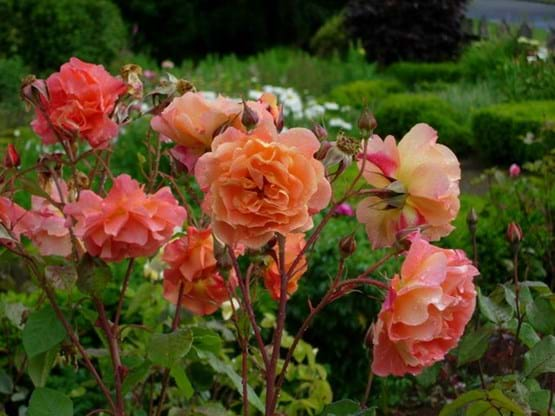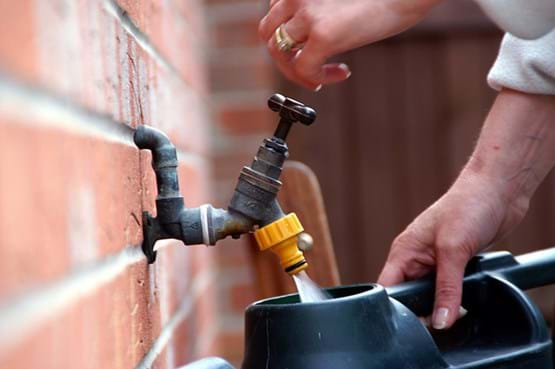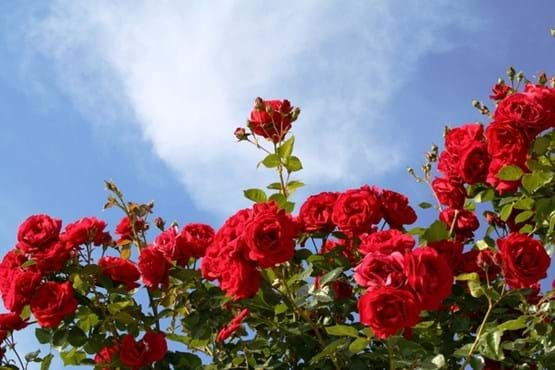Keeping Your Roses Healthy Without Pesticides
To grow beautiful roses, you don’t need to use pesticides and fungicides. By choosing appropriate rose varieties, planting roses properly, and carefully following recommended cultural practices, you can grow roses that are less susceptible to pests and diseases. Roses have certain minimum requirements, so if you have soil that drains slowly or a shady yard (roses need six hours of direct sunlight a day), look for plants that will be more appropriate for your garden. The following tips can help you to protect your family’s health and the environment while you grow strong, healthy roses with glorious blooms.

Where to plant
Before you plant, spend some time finding the best spot in the garden for your roses. Roses need: full sun (>6 hours/day); good drainage; plenty of room to grow. **Consider planting roses in mixed beds rather than traditional rose beds. This diversity of plants will attract beneficial insects and cut down on the spread of rose pests and diseases.
When to plant
Roses purchased in pots can be planted any time of year, but the best selection is available in nurseries from December to May. Potted roses can be planted immediately, or they can remain in their pots for several months. Bare root roses (plants with no soil on their roots) are available December through February. They should be planted right after you buy them so that they don’t dry out. Soak the plants overnight in water before planting.
How to plant
Planting in Containers
For container planting, choose roses that don’t grow more than 4 feet tall. Choose a container at least 20” deep and wide. Use a premium commercial potting soil. You may also want to add organic matter such as compost or high-quality rose planting mix. Make sure to water well after planting.
Planting in the Ground
Dig a hole the depth of the container and at least two times the diameter of the container. For bare root roses dig a hole that will comfortably hold the roots of the plant. Roots need to reach out laterally as far as possible in order to take advantage of water and nutrients.

Do not amend the soil in the planting hole. Research has shown that soil amendments are not necessary in most soils, including clays. Place the rose in the hole so that the bud union (the knobby part of the trunk where the rose was grafted) is 2” to 3” above the soil. For roses grown on their own roots, look for the “root crown,” the area where the roots meet the trunk. Plant with the root crown above the soil, but not so high the roots are exposed.
Fill in the hole with the soil you removed and gently tamp it down. Water thoroughly. If the rose sinks after watering, you may need to remove it and replant it higher to keep the soil from touching the root crown or to keep the bud union at least 2” above the ground. Cover the soil with 2” to 3” of organic mulch.
Less-toxic chemical control for roses
If disease or pest problems are persistent in your garden, you may want to use one of these less toxic chemicals. Because these products prevent but do not cure disease, treatments must begin before symptoms are widespread. Be sure to coat both sides of the leaves. To decrease the possibility of burning leaves or flowers, water plants the day before you treat them and test a few leaves and petals before spraying the whole plant.
Potassium bicarbonate is similar to common baking soda and can be used to prevent powdery mildew. It must be applied weekly. Or, use this baking soda mixture: 1 tablespoon baking soda, plus 2 tablespoons horticultural oil in 1 gallon of water. Spray when you first detect disease, and repeat when new symptoms appear.
Biofungicides attack and outcompete pathogens for nutrients and for space on leaves.
Sulfur and lime can be effective against black spot, powdery mildew, and rust. Do not use when temperatures exceed 85F° because you will burn the leaves.
Neem oil can help prevent powdery mildew, black spot, and rust. Neem oil can be toxic to bees, so it is safest to spray it in the evening.
Antitranspirants and horticultural oil have been observed to provide roses with protection from fungal diseases. They create a thin coating that can prevent spores from fungal diseases from invading the leaves. Treatment is begun when new leaves appear in spring and must be repeated whenever you see new growth. NOTE: In its ready-to-use form, some antitranspirants are too strong for roses. Dilute and use a 1% solution of horticultural oil and water (about 3 tablespoons of oil in 1 gallon of water).

Managing common rose pests and diseases without pesticides
Inspect plants regularly to detect any diseases or pests before they become a problem. Before you treat plants for insect problems, look for beneficial insects such as ladybugs, lacewings, syrphid flies, and orange-and-black soldier beetles. If you see these natural enemies of rose pests, refrain from using an insecticide because you will kill more useful insects than pests.
Powdery Mildew
Symptoms of “powdery mildew” include curled leaves and a white or gray powdery coating on leaves, shoots, and flower buds. Powdery mildew typically grows on new growth and in locations with high humidity. Controls: Plant disease-resistant varieties, wash leaves in early afternoon with a strong spray, avoid heavy fertilization or heavy pruning that causes spurts of new, highly susceptible growth.
Rust
Symptoms of “rust” include small orange or yellow spots on any green portion of the plant. On the leaves, symptoms start on the undersides and progress to the upper surfaces. Rust can develop where there is continuous moisture for 2 to 4 hours at moderate temperatures (e.g., 64°F to 70°F). Controls: Choose resistant varieties, remove and destroy fallen leaves, mulch to prevent spread of spores, remove and destroy infected shoots (look for dark, corky lesions). Use soaker hoses or drip irrigation.
Aphids
Aphids are tiny (1/8”) sucking insects that feed on plant sap. Often found in clusters on new shoots and flower buds, especially on over-fertilized plants. They may cause leaves to discolor or turn black with sooty mold, and natural predators can reduce their numbers. Controls: Wipe off by hand or spray off with water, prune off infested growth, spray with an insecticidal soap, use slowrelease fertilizers to prevent growth spurts.
Black Spot
Symptoms of “black spot” include circular black spots with fringed edges on leaves and stems. Leaves may yellow and drop. Spores overwinter on infected stems and fallen leaves and are spread by splashing water, cultivation, and insects. Black spot can develop at locations with high humidity and when roses are continuously wet for 7 hours. In Idaho, this disease may indicate excessive moisture, insufficient light, or poor air circulation. Controls: Choose resistant varieties, prune away and destroy infected plant material, increase air circulation, destroy fallen leaves, mulch to prevent spread of spores.